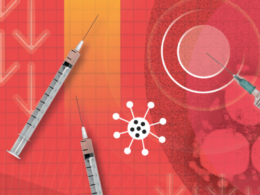Credit to the image: food business news
Nature
Amalio Telenti; Ann Arvin; Lawrence Corey; Davide Corti; Michael S. Diamond; Adolfo García-Sastre; Robert F. Garry; Edward C. Holmes; Phil Pang; Herbert W. Virgin
Abstract
- There is a realistic expectation that the global effort in vaccination will bring the severe acute respiratory syndrome coronavirus 2 (SARS-CoV-2) pandemic under control.
- Nonetheless, uncertainties remain about the type of long-term association the virus will establish with the human population, particularly whether the coronavirus disease 2019 (COVID-19) will become an endemic disease.
Although the trajectory is difficult to predict, the conditions, concepts, and variables that influence this transition can be anticipated.
- Persistence of SARS-CoV-2 as an endemic virus, perhaps with seasonal epidemic peaks,
- may be fueled by pockets of susceptible individuals and waning immunity after infection or vaccination,
- changes in the virus through antigenic drift that diminish protection,
- and reentries from zoonotic reservoirs.
Here, we review relevant observations from previous epidemics and discuss the potential evolution of SARS-CoV-2 as it adapts during persistent transmission in the presence of a level of population immunity.
- Lack of effective surveillance
- or adequate response could
enable the emergence of new epidemic or pandemic patterns from an endemic infection of SARS-CoV-2.
There are key pieces of data that are urgently needed in order to make good decisions. We outline these and propose a way forward.
Excerpt — Where do we see the pandemic going? 3 Scenarios
The first — and most worrisome — scenario is that we will not gain rapid control of this pandemic and thus will face a future with ongoing severe disease manifestations combined with high levels of infected individuals which, in turn, might foster further evolution of the virus.
- Vaccinations and prior infection might achieve long term herd immunity,
- but we will need a very broad application of vaccines worldwide combined with comprehensive disease surveillance by accurate and
readily available diagnostic assays or devices [76].
A second and more likely scenario is the transition to an epidemic seasonal disease like influenza.
- Effective therapies that prevent progression of COVID-19 disease (e.g., monoclonal antibodies reduce hospitalization and death by 70–85%) may bring the burden of SARS-CoV-2 infection to levels that are equivalent or even lower than influenza.
- However, we should remember that the annual mortality burden of influenza, in non-pandemic years, is estimated to be 250,000 to 500,000, with up to 650,000 all-cause deaths globally, comprising ~2% of all annual respiratory deaths (two thirds among people 65 years and older) [77].
This is an extremely significant health burden and equates to a relatively ‘optimistic’ view of the future of the SARS-CoV-2 pandemic.
A third scenario is the transition to an endemic disease similar to other human coronavirus infection that have a much lower disease impact than influenza or SARS-CoV-2.
- There is, however, limited data on the global burden of disease by common human coronaviruses [78] and as noted in earlier sections, it is not possible to predict with confidence whether further adaptations of SARS-CoV-2 to humans will increase or decrease its intrinsic virulence.
To better predict which scenario is likely to emerge and to better equip the world with an appropriate response, we propose several key questions that need to be answered and critical tools that need to be developed (Box 2).
— — — — — — — — — — — — — — — — — — — — — — — — — — — — — — —
BOX 2 — What are the current key gaps in developing an effective global response?
Research Questions Epidemiology
- What are the effects of geographic and socioeconomic variations in vaccine coverage and disease on the ability to convert the pandemic to an endemic/epidemic disease?
- What is the contribution of immunosuppressed populations to the rapid evolution of SARS-CoV-2? Virology
- What are the mechanisms by which viruses adapt to different hosts thereby crossing species barriers?
- Is viral sequence evolution effectively reduced by vaccination? Immunology
- What are the correlates of protection for vaccines and natural immunity? — a process that will require coherent application of reproducible immunologic assays in populations followed for disease incidence and severity.
- What is the impact of antigenic drift?
- What are the criteria for renewal or boosting of vaccines?
- What is the role of mucosal immunity in limiting viral shedding and preventing severe disease?
Tools and Technologies Surveillance
Surveillance
- Globally accessible diagnostics and deep sequencing tools to establish continuous and sustained global surveillance of disease and variants
Vaccines
- Pansarbecovirus vaccines and monoclonal antibodies that will address both SARS-CoV-2 variants and the future introduction of pandemic coronaviruses into the human population.
Therapeutics
- Next generation therapeutics in the form of cheap oral antiviral agents.
- Long-acting monoclonal antibody prophylaxis for persons not likely to achieve effective vaccination.
- Addressing significant inequalities in pandemic health care and access worldwide to the most effective vaccine and therapeutics.
— — — — — — — — — — — — — — — — — — — — — — — — — — — — — — —
These comprise gaps in knowledge in terms of epidemiology, immunology and virology, and missing surveillance, prophylactic, and therapeutic tools.
This pandemic has shown both the importance of individual country initiatives and the interdependence of the world and necessity of cooperation for pandemic control.
It is the investment by a limited number of countries that has led to the biomedical discoveries that have brought forward the tools to interrupt pandemic spread [79].
Yet, the lack of international structures for implementation has brought into focus the disparities between poor and rich both within countries and between countries.
This highlights the current inadequacies in health delivery systems and access to novel biomedical interventions [80].
Global health leaders will need to be vigilant with respect to the trajectory of SARS-CoV-2 in the proximate future while assessing the strategies and approaches utilized in the pandemic to develop more effective structures and processes to insure a more effective and equitable response for the future
To continue reading assess the FULL VERSION in PDF:
Originally published at https://www.nature.com on July 8, 2021.
Cite this article
Telenti, A., Arvin, A., Corey, L. et al. After the pandemic: perspectives on the future trajectory of COVID-19. Nature (2021). https://doi.org/10.1038/s41586-021-03792-w












